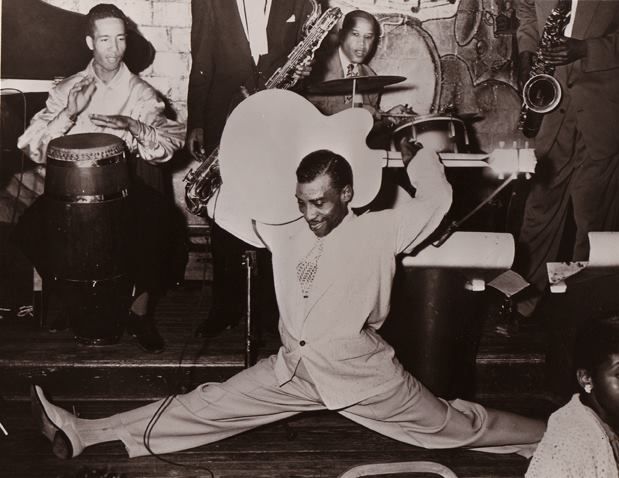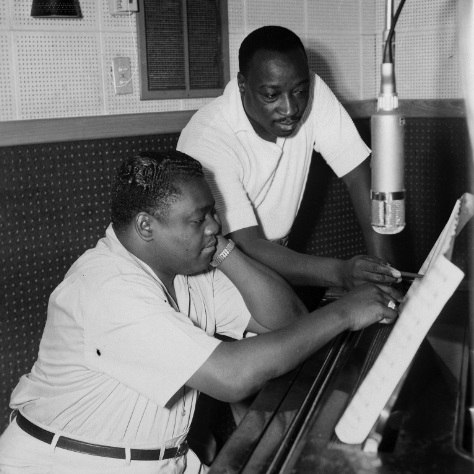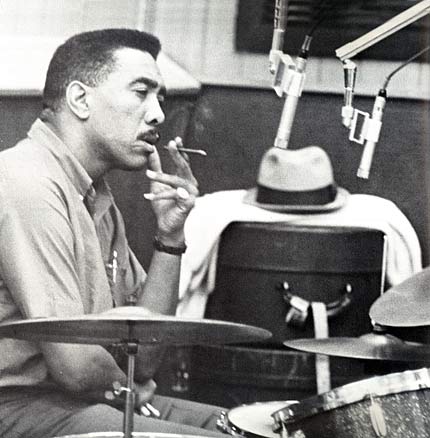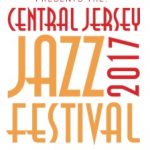Before US trade and travel restrictions over 50 years ago, Cuba’s rich musical output was widely enjoyed in the US via records, live performances by “Latin” orchestras and radio. (In the early uncrowded days of radio, signals from Havana reached as far as New York City.)
American musicians (that is musicians born and raised in the US) didn’t play Cuban music itself, but they listened – and learned.
Here’s some evidence of the impact that listening had on the development of America’s most popular export Rock and Roll.

T-Bone Walker band with conga drummer

Bo Diddley with original band member and musical partner Jerome Green. It could be
a coincidence, but the maracas are a Cuban instrument and Bo Diddley’s signature
beat – 1-2-3-pause-1-2 – is pure clave

Rock and Roll Hall of Famers Dave Bartholomew and Fats Domino
“New Orleans producer-bandleader Dave Bartholomew first employed this (Cuban) figure (as a saxophone-section riff) on his own 1949 disc “Country Boy” and subsequently helped make it the most over-used rhythmic pattern in 1950’s rock ‘n’ roll. On numerous recordings by Fats Domino, Little Richard and others, Bartholomew assigned this repeating three-note pattern not just to the string bass, but also to electric guitars and even baritone sax, making for a very heavy bottom. He recalls first hearing the figure – as a bass pattern on a Cuban disc.”
– Palmer, Robert (1995: 60). An Unruly History of Rock & Roll. New York: Oxford University Press.
The figure Palmer is referring to is the tresillo, a more basic form of the rhythmic figure known as the habanera, a rhythm popularized by Cuban musicians.
“I heard the bass playing that part on a ‘rumba’ record. On “Country Boy” I had my bass and drums playing a straight swing rhythm and wrote out that rumba bass part for the saxes to play on top of the swing rhythm. Later, especially after rock ‘n’ roll came along, I made the ‘rumba’ bass part heavier and heavier. I’d have the string bass, an electric guitar and a baritone all in unison”
What Bartholomew calls a ‘rumba’ record was actually in all probability a ‘son’ record. It was and still is very common in the US to apply the term ‘rumba’ to all Cuban music.
Dave Bartholomew quoted by Palmer, Robert (1988: 27) “The Cuban Connection” Spin Magazine Nov.
If you think you’ve heard this a million times, you have. And if you’d been around in 1950, you would have heard it here first – from a US based musician that is.

Earl Palmer of the legendary “Wrecking Crew”
When he was 16, in 1941, (Palmer) stowed away on a United Fruit Company steamer for a three-day vacation on the down-low in Havana. In Tony Scherman’s oral history/biography of Palmer, Backbeat, Palmer said, “Do you realize Havana, Cuba, in 1941 was one of the wildest places on earth?—gambling and prostitution and dope all over, and music hipper than anything I’d heard to that day.” That there was somewhere with hipper music than New Orleans was quite something for a New Orleanian to admit, but then, he caught New Orleans’ big sister city of Havana at a transcendental moment in Cuba’s golden age of dance music.
Years later, when Tad Jones asked Palmer what was different about New Orleans drumming, he said, “Latin music.” For Palmer, that meant a whole set of moves that became part of his playing, sometimes dropped in with his second line stuff. He came up with ways to synthesize swinging time with the straight time of Afro-Cuban music. His metric mind-funk was essential to Professor Longhair’s 1953 recording of “Tipitina,” and he once analyzed Longhair’s playing as marking a common point between what in New Orleans was called “rumba” and the congruent Mardi Gras Indian rhythms.
– Ned Sublette Cuba and Its Music
Cuban influence on American Rock and Roll?
You betcha.
– Ken McCarthy
Jazz on the Tube
P.S. Our unique programming is made possible by help from people like you. Learn how you can contribute to our efforts here: Support Jazz on the Tube
Thanks.







